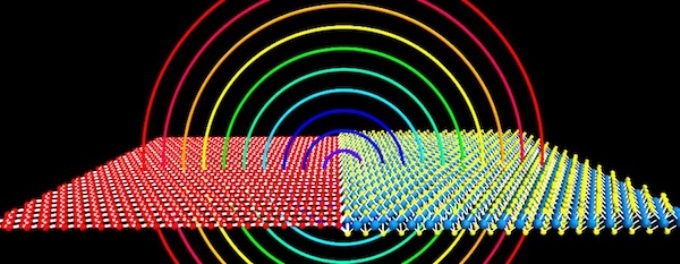Jul 26 2016
Researchers at Rice University lab explore 2D hybrids to see how they are different from standard electronics.
 Hybrids of two-dimensional materials like the graphene-molybdenum disulfide illustrated here have electronic properties that don’t follow the same rules as their 3D cousins, according to Rice University researchers. The limited direct contact between the two materials creates an electric field that greatly increases the size of the p/n junction. (Credit: Henry Yu)
Hybrids of two-dimensional materials like the graphene-molybdenum disulfide illustrated here have electronic properties that don’t follow the same rules as their 3D cousins, according to Rice University researchers. The limited direct contact between the two materials creates an electric field that greatly increases the size of the p/n junction. (Credit: Henry Yu)
Rice University researchers believe that old rules do not always apply when 2D materials are used to develop electronic components.
Boris Yakobson, theoretical scientist of Rice lab, studied hybrids that have 2D materials such as boron nitride and graphene next to each other to observe their effect at the border. The findings revealed that “co-planer” hybrids have different electronic properties as compared to other heavier components.
The July issue of Nano Letters, the American Chemical Society journal, features the results of the study.
In order to shrink electronics, their components must be shrunk. Various labs in universities and industries are exploring ways to use materials such as graphene to create the ultimate thin device by developing circuits with atom-thick layers.
Our work is important because semiconductor junctions are a big field. There are books with iconic models of electronic behavior that are extremely well-developed and have become the established pillars of industry. But these are all for bulk-to-bulk interfaces between three-dimensional metals. Now that people are actively working to make two-dimensional devices, especially with co-planar electronics, we realized that the rules have to be reconsidered. Many of the established models utilized in industry just don’t apply.
Boris Yakobson, Theoretical Scientist, Rice University
A computer stimulation capable of studying the transfer of charge between atom-thick materials has been developed by the team headed by Henry Yu, a student of Rice.
“It was a logical step to test our theory on both metals and semiconductors, which have very different electronic properties,” Yu said. “This makes graphene, which is a metal — or a semimetal, to be precise — molybdenum disulfide and boron nitride, which are semiconductors, or even their hybrids ideal systems to study.”
“In fact, these materials have been widely fabricated and used in the community for almost a decade, which makes analysis of them more appreciable in the field. Furthermore, both hybrids of graphene-molybdenum disulfide and graphene-boron nitride have been successfully synthesized recently, which means our study has practical meaning and can be tested in the lab now,” he said.
The charge transfer in 3D materials take place in a narrow space at the positive and negative (or p/n) junction, said Yakobson. “A highly nonlocalized charge transfer” and an electric field created by 2D interfaces, led to a significant increase in the size of the junction, observed the researchers. They said that this would prove to be beneficial in solar cells and other photovoltaic applications.
A simulation of molybdenum disulfide-graphene hybrid was developed by the lab and a graphene and graphene-boron nitride in which half was doped to develop a p/n junction were also considered. According to the evaluation of the researchers, diodes, transistors and other 2D Schottky or one-way devices can be made more tunable, depending on the device’s size, if an electric field is present.
The lining-up of atoms is also of significance, noted Yakobson. The presence of hexagonal lattices in boron nitride and graphene makes them gel perfectly together. However, another promising material, molybdenum disulfide, though considered to be 2D is not completely flat.
If the atomic structures don’t match, you get dangling bonds or defects along the borderline. The structure has consequences for electronic behavior, especially for what is called Fermi level pinning.
Boris Yakobson, Theoretical Scientist, Rice University
Yakobson also stated that “pinning” can create an energy barricade at the interface and bring down the electrical performance. “But your Schottky barrier (in which current moves in only one direction) doesn’t change as expected. This is a well-known phenomenon for semiconductors; it’s just that in two dimensions, it’s different, and in this case may favor 2D over 3-D systems.”
The principles stated in the recent paper will be applicable to all patterned hybrids that consists of multiple 2D patches, confirmed Yakobson.
You can make something special, but the basic effects are always at the interfaces. If you want to have many transistors in the same plane, it’s fine, but you still have to consider effects at the junctions. There’s no reason we can’t build 2D rectifiers, transistors or memory elements. They’ll be the same as we use routinely in devices now. But unless we develop a proper fundamental knowledge of the physics, they may fail to do what we design or plan.
Boris Yakobson, Theoretical Scientist, Rice University
The paper has been co-authored by Alex Kutana, a postdoctoral research associate at Rice University. Yakobson is a chemistry professor and the Karl F. Hasselmann Professor of Materials Science and NanoEngineering.